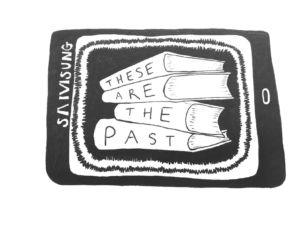At Redwood, sometimes it feels like there is so much pressure to succeed―to learn better, to learn more, to learn faster. This pressure, however, does not need to be as significant as it currently is because there is an easy, cost-effective solution that could help students at Redwood learn more quickly and efficiently: replacing textbooks with tablets.
Since the Los Angeles Unified School District implemented this change in 2015, students’ engagement levels have risen by more than 40 percent, according to Businessweek. Businessweek also stated that along with increased engagement, students enjoyed using the tablets and became more eager to learn.
According to the U.S. Department of Education, technology-based instruction, such as tablet use, can reduce the time students take to reach a learning objective by up to 80 percent. Tablets are also desirable because they can be used as an organizational tool, unlike textbooks. Students are able to use features on tablets such as highlighting and underlining, something I wish I was able to do in order to retain important information during in-class discussion or when writing papers. This is a technological advantage not offered with textbooks. Textbooks cannot support multimedia productions such as videos and editing tools. Textbooks cannot allow for diversification of learning styles. And perhaps most important, textbooks cannot adequately prepare students for life after high school because they do not prepare them for a technologically-immersive world. As someone who has grown up using technology constantly, I believe that tablets can help students prepare for a successful career by incorporating what are now essential life skills into the classroom.

Not only would tablets at Redwood better prepare students for the future, they would also alleviate the health problems caused by heavy textbooks. A backpack that is more than 10 percent of one’s body weight can cause spine and back problems, according to CNN Health. In 2013, more than 1,500 kids nationwide were treated for backpack-related injuries.
This problem is easily solvable. The average weight of a high school textbook is 4.8 pounds, whereas the average weight of a tablet is only 1.5 pounds, not to mention it is only necessary to carry one tablet versus the average two to three textbooks carried per student. Sometimes I feel like I am carrying the weight of the world on my shoulders, but then I realize that it is just my backpack. Yet talking about the weight of my backpack does not even begin to cover the weight of everything people carry at school. Some students bring laptops and binders along with the many textbooks inside their backpacks, putting even more strain on their backs. For students like me who have to carry multiple bags to and from school due to sports or other extracurricular activities, the textbook weight can be especially strenuous. For Redwood students, it would be much less grueling to have tablets instead of textbooks.
Critics of introducing tablets to schools would argue that they are too expensive and cannot be realistically given to every student in our school district. Though this may once have been a valid point, tablet prices reached a low of about $150 in 2016, and still continue to drop, according to Forbes. Meanwhile, textbooks cost an average of $250 each and students may need more textbooks than tablets. Technology such as e-textbooks can save schools $250 to $1,000 per student each year, according to the Federal Communications Commission.
Besides saving the school money, switching from textbooks to tablets may also improve student performance on standardized tests. At Redwood, and in the Marin community as a whole, there is a strong emphasis on performing well on standardized tests like the SAT and ACT in order to be accepted to a desirable college. In California’s Riverside Unified School District, students who used tablets scored 20 percent higher on standardized tests than the students who used traditional textbooks. If Redwood were to incorporate tablets into the learning environment, students would be better positioned for acceptance into the colleges of their choice.
The implementation of tablets instead of textbooks would better prepare Redwood students for a world immersed in technology. Students would naturally become more engaged with the material being taught and would perform better on standardized tests. All of these outcomes are ones that the school spends money trying to achieve, which is why it is ironic that the solution, switching from textbooks to tablets, could cheaply achieve these goals. Redwood must replace textbooks with tablets in order to allow students a better chance at the success they deserve.







